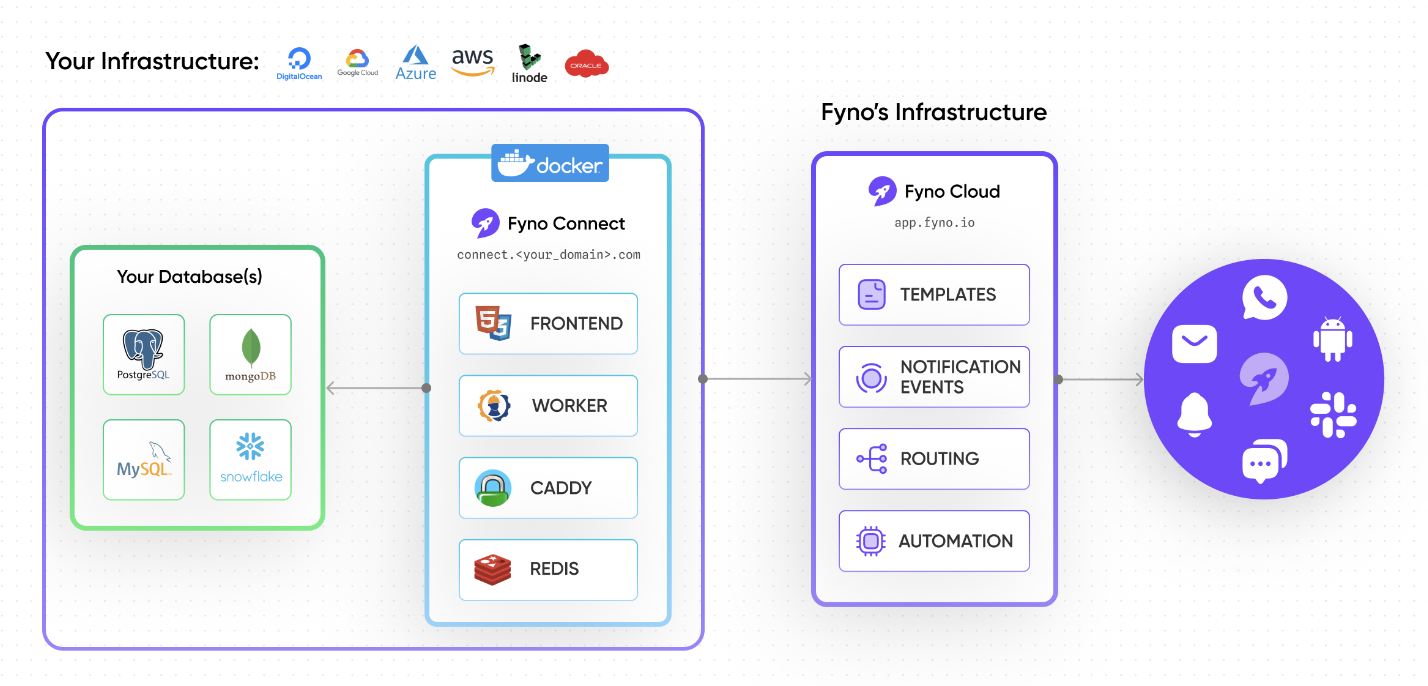Fyno Connect
Fyno Connect serves as your solution for directly creating user cohorts from your Database (DB) or Data Warehouse (DW). This application runs on your infrastructure, guaranteeing 100% security.
Fyno Connect comes with a pre-configured integration with our Fyno cloud platform. This allows you to initiate any communication you've designed on the cloud platform directly to users through cohorts you've created on Connect. All of this is accomplished without the need for concerns about API integration or coding.

Prerequisites for Fyno Connect
Before installing Fyno Connect, you will need to have the following:
- A Fyno Cloud account, preferably with a few templates, routes and notification events created and ready for testing.
- A VM (Virtual Machine), where this instance of Fyno Connect will be set up. This can be anything from AWS EC2 to Azure Compute Services, whichever best suits your set-up and needs. Please install the latest version of docker in this VM.
- A CNAME or A record pointing your Fyno Connect sub-domain (example: connect.example.com) to this VM.
- Allow public access to ports 80 and 443 of this VM for automatic SSL certificate creation. This can be disabled later.
Setting up and installing Fyno Connect
- In your VM, install the latest version of docker and docker-compose.
- Download the Fyno Connect zip file (we will share this with you) in the VM and extract the files.
- Edit the
.envfile in the folder where you have extracted the zip file. In this file add your Fyno Workspace ID and API Key details. You can fetch these values from Fyno Cloud API Keys page.
FYNO_WSID=<your_fyno_workspace_id>
FYNO_API_KEY=<your_fyno_api_key>
- Next, edit the
Caddyfilelocated in thedocker-datafolder. Add your email ID, which will be used to create your SSL certificate, and the address of the domain you would use for Fyno Connect.
{
email <YOUR_EMAIL>
}
connect.example.com {
handle_path /api/app/* {
reverse_proxy connect-frontend:4005
}
handle {
reverse_proxy connect-frontend:3000
}
}
- Once done, run the
start.shshell script to startup Fyno Connect.
./start.sh
OR
sh start.sh
- If the setup is successful, you will be able to access Fyno Connect via the sub-domain (example: connect.example.com) you used above.
- You may now restrict public access for ports 80 and 443 to your Fyno Connect domain.
delete.shandupdate.shworks too!For when you want to remove Fyno Connect or update it!
Using Fyno Connect
You can access Fyno Connect using the sub-domain you created earlier (example: connect.example.com).
Let's have a look around Fyno Connect and understand what you can achieve with it.
Databases
Fyno Connect works by directly connecting with your database and giving you a platform to essentially create cohorts and mould your data without having to extract it.
Supported databases to connect:
- MongoDB
- Snowflake
- Postgres
- MySQL
- MsSQL
1. MongoDB
To connect to MongoDB,
- Navigate to Databases and click on MongoDB
- In the pop-up, enter a name for the new connection and paste the MongoDB connection string or URL.
- Click on "Add Database" to test the connection and successfully save it.
Make sure your MongoDB connection string is on point!
The standard connection string format looks like:
mongodb://[username:password@]host1[:port1],host2[:port2],...[,hostN[:portN]]][/[database][?options]]
2.Snowflake
To connect to Snowflake,
- Navigate to Databases and click on Snowflake
- In the pop-up, enter the following details.
- custom name - Unique name to identify your snowflake connection in Fyno.
- accountname - Refer this doc to learn how to identify or retrieve the account name from your Snowflake account.
- username
- password
- warehousename
- dbname
- Click on "Add Database" to test the connection and successfully save it.
3.Postgres
To connect to Postgres,
- Navigate to Databases and click on Postgres
- In the pop-up, enter a name for the new connection and paste the MongoDB connection string or URL.
- Click on "Add Database" to test the connection and successfully save it.
Make sure your Postgres connection string is on point!
The standard connection string format looks like:
postgresql://[user\[:password\]@][netloc][:port][/dbname][?param1=value1&...]
4. MySQL
To connect to MySQL,
- Navigate to Databases and click on MySQL
- In the pop-up, enter the following details
- Custom Name
- Host Address
- Database name
- Username
- Password
- Click on "Add Database" to test the connection and successfully save it.
5. MsSQL
To connect to MSSQL,
- Navigate to Databases and click on MsSQL
- In the pop-up, enter the following details
- Custom Name
- Server
- Database name
- Port
- Username
- Password
- Click on "Add Database" to test the connection and successfully save it.
Once the Database has been added successfully, you will see it listed on the same page under Connected DBs
On clicking on any of the connected databases, you will be able to view all the collections and their data in a tabular form. Filtering the data as per your needs is also possible by either applying filters or writing a query.
This gives you a better understanding as well as visualization of the data you are working with, allowing you to build cohorts easily.
Updated 2 months ago
